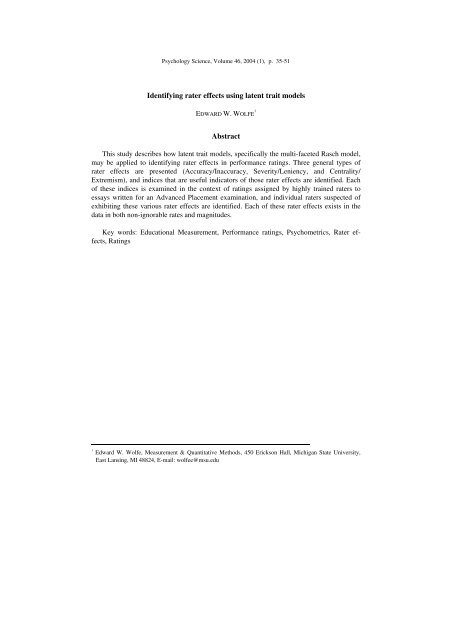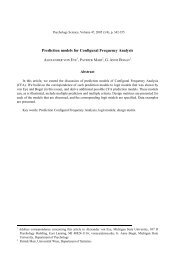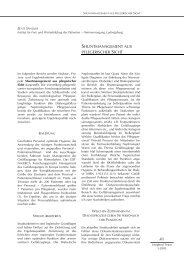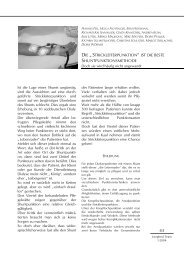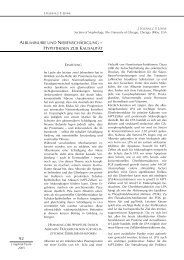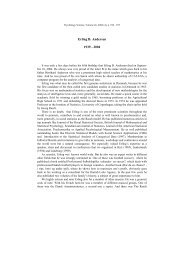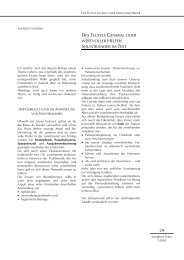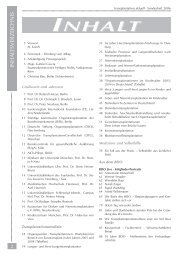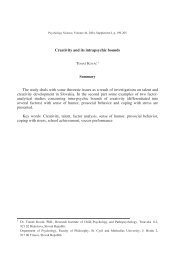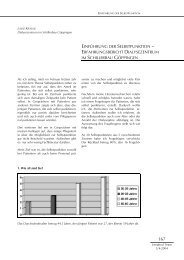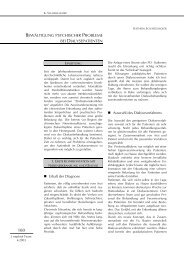Identifying rater effects using latent trait models Abstract
Identifying rater effects using latent trait models Abstract
Identifying rater effects using latent trait models Abstract
You also want an ePaper? Increase the reach of your titles
YUMPU automatically turns print PDFs into web optimized ePapers that Google loves.
Psychology Science, Volume 46, 2004 (1), p. 35-51<br />
<strong>Identifying</strong> <strong>rater</strong> <strong>effects</strong> <strong>using</strong> <strong>latent</strong> <strong>trait</strong> <strong>models</strong><br />
EDWARD W. WOLFE 1<br />
<strong>Abstract</strong><br />
This study describes how <strong>latent</strong> <strong>trait</strong> <strong>models</strong>, specifically the multi-faceted Rasch model,<br />
may be applied to identifying <strong>rater</strong> <strong>effects</strong> in performance ratings. Three general types of<br />
<strong>rater</strong> <strong>effects</strong> are presented (Accuracy/Inaccuracy, Severity/Leniency, and Centrality/<br />
Extremism), and indices that are useful indicators of those <strong>rater</strong> <strong>effects</strong> are identified. Each<br />
of these indices is examined in the context of ratings assigned by highly trained <strong>rater</strong>s to<br />
essays written for an Advanced Placement examination, and individual <strong>rater</strong>s suspected of<br />
exhibiting these various <strong>rater</strong> <strong>effects</strong> are identified. Each of these <strong>rater</strong> <strong>effects</strong> exists in the<br />
data in both non-ignorable rates and magnitudes.<br />
Key words: Educational Measurement, Performance ratings, Psychometrics, Rater <strong>effects</strong>,<br />
Ratings<br />
1<br />
Edward W. Wolfe, Measurement & Quantitative Methods, 450 Erickson Hall, Michigan State University,<br />
East Lansing, MI 48824, E-mail: wolfee@msu.edu
36<br />
E. W. Wolfe<br />
<strong>Identifying</strong> Rater Effects Using Latent Trait Models<br />
Human judgment is used to assign ratings in a wide variety of domains. Judges rate the<br />
athletic performance of gymnasts and divers. Connoisseurs rate the quality of wine and beer.<br />
Employers rate the suitability of job applicants. Judges rate the degree to which animals<br />
exhibit the idealized characteristics of that animal’s pedigree. Educators rate the performance<br />
of students on constructed-response achievement test items. When important decisions are<br />
made based upon such ratings, it is essential that the assigned ratings are accurate and fair.<br />
As a result, <strong>rater</strong> selection, training, and monitoring procedures are often employed for the<br />
purpose of minimizing the impact of <strong>rater</strong> inaccuracy or bias on ratings.<br />
One example of efforts such as these arises in educational achievement tests that require<br />
the examinee to write an essay in response to an examination question. Such questions are<br />
common on the Test of English as a Foreign Language (TOEFL), the Scholastic Aptitude<br />
Test (SAT), and the Advanced Placement (AP) examinations. In these large-scale, highstakes<br />
examination settings, <strong>rater</strong>s typically must meet minimum qualifications in order to be<br />
selected as a <strong>rater</strong>, such as having earned a graduate degree and having teaching experience<br />
in the content area of the examination. Once selected for a rating project, <strong>rater</strong>s undergo<br />
hours or even days of training to learn the criteria upon which ratings will be assigned, review<br />
rated exemplars of examinee responses, practice assigning ratings to example responses,<br />
discuss the ratings they assign with other <strong>rater</strong>s to clarify the fine points of the rating<br />
criteria, and receive feedback on their progress toward mastering the rating criteria. Often,<br />
<strong>rater</strong>s must demonstrate mastery of the rating criteria by achieving a minimum level of<br />
agreement with expert <strong>rater</strong>s on pre-scored example responses prior to assigning ratings that<br />
are reported to students. In addition, <strong>rater</strong>s are frequently monitored throughout the rating<br />
session to verify that their ratings maintain desirable levels of accuracy, and <strong>rater</strong>s who exhibit<br />
drift away from the adopted standards for performance may be retrained or removed<br />
from the rating session.<br />
Regardless of the efforts taken to minimize inaccuracy and bias in ratings, idiosyncrasies<br />
exist in the behaviors of <strong>rater</strong>s, and systematic patterns in these behaviors are termed <strong>rater</strong><br />
<strong>effects</strong>. Because <strong>rater</strong> <strong>effects</strong> are systematic, they are detectable as patterns in the ratings<br />
assigned by the <strong>rater</strong>s. This manuscript identifies several classes of <strong>rater</strong> <strong>effects</strong>, explains<br />
how a <strong>latent</strong> <strong>trait</strong> measurement model can be used to detect these <strong>rater</strong> <strong>effects</strong>, and presents<br />
an empirical example of such an application.<br />
Rater Effects<br />
Most research concerning <strong>rater</strong> <strong>effects</strong> has examined those <strong>effects</strong> <strong>using</strong> three methodologies.<br />
One line of research has focused on <strong>rater</strong> cognition and the relationship between a<br />
<strong>rater</strong>'s cognitive processing and focus and that <strong>rater</strong>'s proficiency (Breland & Jones, 1984;<br />
Freedman, 1979; Freedman & Calfee, 1983; Pula & Huot, 1993; Vaughan, 1991; Wolfe,<br />
1997; Wolfe, Kao, & Ranney, 1998). These types of studies tend to emphasize differences<br />
between expert and novice <strong>rater</strong>s, and the results mirror expert-novice differences observed<br />
in other domains (Glaser & Chi, 1988). Specifically, those studies have shown that expert<br />
<strong>rater</strong>s tend to focus on very specific characteristics of the essays and conceptualize the rating<br />
process holistically.
Rater <strong>effects</strong> 37<br />
Another line of research has focused on characteristics of <strong>rater</strong>s, the rating task, and the<br />
rating environment that relate to the presence of <strong>rater</strong> <strong>effects</strong> in ratings (Dean, 1980; Hoyt,<br />
1999; Hoyt, 2000; Jako & Murphy, 1990; McIntyre, Smith, & Hassett, 1984; Murphy &<br />
Anhalt, 1992; Tziner & Murphy, 1999; Welch & Swift, 1992; Yu & Murphy, 1993). Some of<br />
these studies have suggested that the manner in which information is presented to <strong>rater</strong>s and<br />
the way that <strong>rater</strong>s process that information may introduce certain types of <strong>rater</strong> <strong>effects</strong>, such<br />
as proximity errors or halo <strong>effects</strong>. Others have suggested that certain types of errors have a<br />
more severe impact on the reliability and validity of ratings.<br />
The third line of research has focused on the impact of <strong>rater</strong> <strong>effects</strong> on ratings and developing<br />
methods for statistically modeling and correcting for <strong>rater</strong> <strong>effects</strong> (Braun, 1988; de<br />
Gruijter, 1984; Engelhard, 1992, 1994, 1996; Houston, Raymond, & Svec, 1991; Longford,<br />
1996; Lunz, Wright, & Linacre, 1990; Murphy & Balzer, 1989; Raymond & Viswesvaran,<br />
1993; Vance, Winne, & Wright, 1983; Wolfe, Chiu, & Myford, 2000). Several of these authors<br />
have relied on analyses of raw scores and applications of generalizability theory. More<br />
recent efforts have focused on the development and utilization of <strong>latent</strong> <strong>trait</strong> applications.<br />
The study presented here is consistent with these more recent efforts. Prior to presenting<br />
those <strong>latent</strong> <strong>trait</strong> procedures, however, several types of <strong>rater</strong> <strong>effects</strong> that may be detected<br />
<strong>using</strong> these methods will be presented.<br />
Accuracy/Inaccuracy<br />
One of the most common concerns of those who utilize ratings to make decisions is<br />
whether <strong>rater</strong>s have been sufficiently trained or have sufficient expertise to assign accurate,<br />
rather than inaccurate, ratings. The ability to assign accurate ratings (i.e., the demonstration<br />
of <strong>rater</strong> accuracy) may be the result of experiences that the <strong>rater</strong> has had (e.g., training, education,<br />
work experiences), cognitive factors (e.g., thinking styles, learning abilities), and<br />
characteristics of the rating criteria (e.g., degree of similarity of the criteria and the <strong>rater</strong>’s<br />
beliefs and understanding of the domain in question) and the rating environment (e.g., freedom<br />
from distractions, types of social interactions that occur in that setting). Hence, the most<br />
suitable <strong>rater</strong>s maybe those who have thinking styles and belief systems that are consistent<br />
with the training approach and rating criteria. In addition, <strong>rater</strong> training, <strong>rater</strong> monitoring, and<br />
the structure of the rating task may facilitate accuracy by providing a suitable rating environment.<br />
Inaccuracy, the converse of accuracy, is a <strong>rater</strong> effect that is typically avoided by<br />
those who supervise the assignment of ratings.<br />
Rater accuracy and inaccuracy can be defined statistically by considering the impact that<br />
each of these <strong>effects</strong> has on the residuals of the observed scores from their expectations. The<br />
expected rating is the value of the expectation of assigned ratings across an innumerably<br />
large number of contexts (<strong>rater</strong>s, time, items, etc.). This expectation is sometimes referred to<br />
as the “true” rating (in true score test theory) or as the expected score derived from the rated<br />
individual’s parameter-based ability (in <strong>latent</strong> <strong>trait</strong> test theory). While <strong>rater</strong> accuracy results<br />
in a high degree of consistency between assigned ratings and expected, or known-to-be-valid,<br />
ratings 1 , <strong>rater</strong> inaccuracy results in low levels of consistency between assigned ratings and<br />
expected ratings. In this sense, accuracy manifests itself as small, randomly distributed patterns<br />
of residuals, where the residual is defined as the difference between the observed rating<br />
(X) and its expectation [E(X)], residual = X - E(X). That is, <strong>rater</strong> accuracy should result in a
38<br />
E. W. Wolfe<br />
standard deviation of the residuals that is small, and a correlation between the residual and<br />
E(X) that is near zero. Rater inaccuracy would also result in independence between residuals<br />
and E(X) (i.e., r residual,expected<br />
is near zero), but, the standard deviation of the residuals would be<br />
large. These patterns are displayed in Figure 1.<br />
Figure1:<br />
Rater Accuracy and Inaccuracy Residual Patterns<br />
Harshness/Leniency<br />
The most commonly researched <strong>rater</strong> effect occurs when <strong>rater</strong>s utilize the same criteria<br />
but adopt different levels of stringency within that framework. In these cases, the rank ordering<br />
of ratings assigned by different <strong>rater</strong>s is very consistent, but the average ratings are different.<br />
Raters who tend to assign lower scores are said to be severe or harsh while <strong>rater</strong>s who<br />
tend to assign higher scores are said to be lenient. In the purest case, harsh and lenient <strong>rater</strong>s<br />
assign ratings that are perfectly correlated with expected ratings. As a result, the standard<br />
deviation of the observed residuals would be near zero, and the residuals and E(X) will be<br />
independent of one another. Rater harshness and leniency can be explicitly modeled in the<br />
<strong>latent</strong> <strong>trait</strong> framework described here as locations of <strong>rater</strong>s on the underlying linear contin-
Rater <strong>effects</strong> 39<br />
uum, and the residuals from this model take those locations into account. As a result, the<br />
mean residual would be near zero as well.<br />
In norm-referenced measurement frameworks (i.e., those in which ratings derive their<br />
meaning from their relative standing in the distribution of ratings), <strong>rater</strong> harshness and leniency<br />
do not influence relative standings of objects of measurement when comparisons are<br />
made between <strong>rater</strong>s. When all <strong>rater</strong>s rate all objects of measurement and only <strong>rater</strong> harshness<br />
or leniency exists (i.e., no other <strong>rater</strong> <strong>effects</strong>, such as inaccuracy), a simple average or<br />
sum of the ratings assigned by all <strong>rater</strong>s reproduces the distribution of expected ratings with<br />
only a constant shift of that distribution. As a result, norm-referenced comparisons would<br />
result in perfectly reliable decisions about the objects of measurement in the case of pure<br />
harshness and leniency with a complete rating design. However, when rating designs are<br />
incomplete (i.e., when only a portion of the <strong>rater</strong>s assign ratings to any given object of measurement<br />
2 – a characteristic that is common in large-scale rating projects for the sake of minimizing<br />
cost), the existence of <strong>rater</strong> harshness or leniency may influence the relative standing<br />
of individual objects of measurement, depending on the level of harshness or leniency of the<br />
subset of <strong>rater</strong>s who assign ratings to that object of measurement. Clearly, the influence of<br />
<strong>rater</strong> harshness and leniency can be minimized by increasing the number of <strong>rater</strong>s who assign<br />
ratings to any given object of measurement and ensuring that the assignment of <strong>rater</strong>s to<br />
objects of measurement is random. Generalizability Theory provides a measurement model<br />
that allows for the prediction of reliability under various rating designs (Brennan, 1992;<br />
Shavelson & Webb, 1991).<br />
A similar, but slightly more complicated, problem exists when harshness and leniency<br />
enter into the ratings assigned in a criterion-referenced interpretive framework. In this case,<br />
decisions are not accurate under complete or incomplete rating designs. In the case of complete<br />
rating designs, the shift of the distribution of ratings from the distribution of expected<br />
ratings by a constant results in a different proportion of objects of measurement above and<br />
below the established cut score. In the case of incomplete rating designs, the shift of subsets<br />
of objects of measurement associated with each <strong>rater</strong> or subset of <strong>rater</strong>s will result in similar<br />
changes in the proportion of objects of measurement falling above or below the cut score, but<br />
the magnitude of these shifts will depend on the degree to which harshness or leniency is<br />
pervasive in that <strong>rater</strong> subset’s ratings. In either case, increasing the number of <strong>rater</strong>s will<br />
only result in a reproduction of the distribution of expected ratings if the distribution of <strong>rater</strong><br />
harshness and leniency is symmetrically distributed around a value of zero.<br />
Centrality/Extremism<br />
A less common concern, but one that is likely to be prevalent in rating projects in which<br />
<strong>rater</strong>s are monitored <strong>using</strong> methods that rely on inter-<strong>rater</strong> comparisons, occurs whether<br />
<strong>rater</strong>s have sufficiently mastered the rating criteria but they apply the extreme categories of<br />
the rating scale differentially. Specifically, <strong>rater</strong>s who tend to assign fewer scores at both the<br />
high and low ends of the rating scale are said to exhibit centrality. This results in a concentration<br />
of assigned ratings in the middle of the rating scale. A similar <strong>rater</strong> effect, one that<br />
will not be explored in this article, named restriction of range exists when centrality is combined<br />
with leniency or harshness (Saal, Downey, & Lahey, 1980). That is, restriction of<br />
range results in a restricted dispersion of ratings around a non-central location on the rating
40<br />
E. W. Wolfe<br />
scale. The converse of <strong>rater</strong> centrality occurs when <strong>rater</strong>s tend to overuse the extreme rating<br />
scale categories – a <strong>rater</strong> effect called extremism.<br />
Rater centrality and extremism manifest themselves in both the pattern and the spread of<br />
the residuals. When centrality occurs, the observed ratings regress toward the center of the<br />
rating scale. As a result, residuals tend to be large and positive for low expected ratings and<br />
large and negative for high expected ratings, as shown in Figure 2. However, to understand<br />
the impact of this trend on summary statistics for the residuals, one must consider the distribution<br />
of the expected scores. Just above the x-axis of Figure 2, a unimodal, centered, and<br />
symmetrical distribution of expected ratings has been superimposed. Notice that the greatest<br />
density of expected ratings corresponds to the point on the residual axis where residuals are<br />
small. As a result, taking the standard deviation of the residuals across this particular sample<br />
of expected ratings results in a residual standard deviation that is near zero. Also, note that<br />
the pattern of residuals is negatively correlated with the expected ratings due to <strong>rater</strong> centrality<br />
(i.e., r residual,expected<br />
approaches -1.00).<br />
2<br />
Residual<br />
0<br />
-2<br />
-4<br />
0 1 2 3 4 5 6 7 8 9<br />
Expected<br />
Figure 2:<br />
Rater Centrality Residual Patterns<br />
Figure 3 demonstrates the influence of <strong>rater</strong> extremism on the residuals. When extremism<br />
occurs, the observed ratings are pushed into the tails of the rating scale. As a result, residuals<br />
tend to be near zero for extreme expected ratings. The absolute value of the residuals increases<br />
as the expected rating approaches the center of its distribution. Taking into account<br />
the distribution of expected ratings superimposed near the x-axis of Figure 3, it seems that
Rater <strong>effects</strong> 41<br />
the standard deviation of the residuals will likely be large because the largest absolute residuals<br />
are located at the most dense location of the distribution of expected ratings. In addition,<br />
because of this density pattern, r residual,expected<br />
will approach 1.00.<br />
2<br />
Residual<br />
0<br />
-2<br />
-4<br />
0 1 2 3 4 5 6 7 8 9<br />
Expected<br />
Figure 3:<br />
Rater Extremism Residual Patterns<br />
A Statistical Summary<br />
In the previous discussion, several types of <strong>rater</strong> <strong>effects</strong> were described according to the<br />
behavior of the residuals that arise when those <strong>rater</strong> <strong>effects</strong> occur. Table 1 summarizes those<br />
characteristics. Specifically, we expect accurate <strong>rater</strong>s to produce residuals that have a standard<br />
deviation close to zero with no correlation between the magnitude of the residual and<br />
the expected rating. Inaccurate <strong>rater</strong>s are expected to produce residuals that also exhibit no<br />
correlation with the expected ratings, but the standard deviation of the residuals will be large.<br />
Lenient and harsh <strong>rater</strong>s will produce residuals that are tightly clustered (i.e., the standard<br />
deviation will be close to zero), and the residuals will not be correlated with the expected<br />
ratings. As explained in the next section, a parameter of the <strong>latent</strong> <strong>trait</strong> model will be useful<br />
for differentiating these two <strong>effects</strong> from the accuracy effect. Central <strong>rater</strong>s will produce<br />
residuals with standard deviations near zero. However, unlike accurate <strong>rater</strong>s, central <strong>rater</strong>s<br />
will produce residuals that are negatively correlated with expected scores. Similarly, extreme<br />
<strong>rater</strong>s will produce residuals with large standard deviations, and the residuals will be positively<br />
correlated with expected scores.
42<br />
E. W. Wolfe<br />
Table 1:<br />
Statistical Summary of the Influence of Rater Effects on Residuals<br />
Rater Effect SD residual<br />
r residual,E(X)<br />
Accuracy<br />
Inaccuracy<br />
0<br />
•<br />
0<br />
0<br />
Leniency<br />
Severity<br />
0<br />
0<br />
0<br />
0<br />
Centrality<br />
Extremism<br />
0<br />
•<br />
-1.00<br />
1.00<br />
The Multifaceted Rasch Model<br />
The multifaceted Rasch model extends the family of Rasch <strong>models</strong> to cases in which<br />
multiple facets of measurement (i.e., elements of the measurement context that may contribute<br />
to measurement error) are modeled (Linacre, 1994; Wright & Masters, 1982). In the case<br />
of <strong>rater</strong> <strong>effects</strong>, the multifaceted Rasch model may be used to control for error contributed by<br />
systematic variability between both items and <strong>rater</strong>s. Although there are several versions of<br />
the multifaceted Rasch model, only the Multifaceted Rasch Rating Scale Model (MRRSM)<br />
will be discussed in this article. 3 As with all Rasch <strong>models</strong>, the MRRSM depicts the additive<br />
contribution of each element of the measurement context to the log of the odds (the logit) of<br />
observing one rating scale category versus the next lower rating scale category <strong>using</strong> parameters<br />
that represent the object of measurement and facets of the measurement context such as<br />
<strong>rater</strong>s and items. Mathematically, we can express this relationship as<br />
⎛ P ⎞<br />
x<br />
LN ⎜ ⎟ = θn − λr − δ<br />
ik, (1)<br />
⎝ P<br />
x−1<br />
⎠<br />
where θ n<br />
is the location of the object of measurement on the underlying linear continuum, λ r<br />
is the location of <strong>rater</strong> r, and δ ik<br />
is the location of the threshold (k) between categories x and<br />
x-1 on the rating scale for item i. In the case of the MRRSM, the location of each threshold is<br />
held constant across all items. Rasch scaling software typically employs maximum likelihood<br />
methods to estimate the values of parameters based on observed ratings.<br />
As is evident in this equation, the location of the underlying <strong>rater</strong> directly influences the<br />
probability of observing a particular category for the object of measurement in question.<br />
Hence, it is clear that λ r<br />
depicts the harshness or leniency of <strong>rater</strong> r. By examining the relative<br />
magnitudes of the λ r<br />
estimates for a particular set of ratings, one can identify <strong>rater</strong>s who<br />
are harsh or lenient relative to the pool of <strong>rater</strong>s. Standard errors can be estimated for each of<br />
these parameter estimates, and Wald statistics<br />
2<br />
⎛ ⎞<br />
2 λr<br />
χ<br />
Wald<br />
= , (1)<br />
⎜ ⎟<br />
⎝<br />
SE λ r ⎠
Rater <strong>effects</strong> 43<br />
can be computed to identify <strong>rater</strong>s who deviate from a group mean (i.e., null value) of 0 by a<br />
statistically significant degree 4 .<br />
Model-based expected values can also be computed for each <strong>rater</strong>-by-measurement object-by-item<br />
combination,<br />
nir<br />
= ∑∑<br />
N I<br />
E kπ , (3)<br />
n= 1 i=<br />
1<br />
nirk<br />
where<br />
π<br />
exp<br />
n r ik<br />
j = 0<br />
nirk<br />
=<br />
m k<br />
∑<br />
exp<br />
x<br />
∑<br />
θ −λ −δ<br />
∑<br />
θ −λ −δ<br />
n r ik<br />
k= 0 j=<br />
0<br />
, (4)<br />
δ so that<br />
i0 ≡ 0<br />
0<br />
∑ n r ik<br />
j = 0<br />
θ − λ − δ = 0 ,<br />
and x is a count of the number of rating scale thresholds exceeded by an object of measurement<br />
(ranging from 0 to m).<br />
The residuals of observed ratings from these model-based expectations, X nir<br />
– E nir<br />
, can be<br />
used to identify <strong>rater</strong> accuracy/inaccuracy and <strong>rater</strong> centrality/extremism as specified in the<br />
previous section of this article. Specifically, smaller residual standard deviations are associated<br />
with <strong>rater</strong> accuracy and centrality, while larger residual standard deviations are associated<br />
with <strong>rater</strong> inaccuracy and extremism. Rater accuracy and centrality can be differentiated<br />
by examining the correlation between the residual and the expected rating associated with<br />
that residual (r residual,expected<br />
). If the correlation between the residual and expected rating is near<br />
zero then <strong>rater</strong> accuracy is indicated. On the other hand, if the residual-expected correlation<br />
is negative, then <strong>rater</strong> centrality is indicated. Rater inaccuracy and extremism can be differentiated<br />
in a similar way – the correlation between residuals and expected ratings should be<br />
near zero in the case of <strong>rater</strong> inaccuracy and should be positive in the case of extremism.<br />
Method<br />
Instrumentation<br />
Each year, high school students in the United States participate in Advanced Placement<br />
(AP) courses, and they may elect to take an examination covering the content of that course<br />
in order to receive college credit for participating in the AP course. The AP course in English<br />
Literature and Composition engages students in reading and critical analysis of imaginative<br />
literature. Through the reading of selected texts, students deepen their understanding of the<br />
ways writers use language to provide both meaning and pleasure for their readers. The examination<br />
for the English Literature and Composition course contains a 60-minute multiple-
44<br />
E. W. Wolfe<br />
choice section and two 60-minute essay questions (Advanced Placement Program, 2003a).<br />
The data for this study were taken from a single essay prompt requiring students to read and<br />
respond to a humorous text.<br />
Raters<br />
Essay questions for the English Literature and Composition Examination were scored by<br />
101 readers who were selected to be highly qualified and were trained extensively to provide<br />
fair, uniform, and accurate ratings. Each year, developers of the AP examinations create<br />
detailed scoring guidelines, thoroughly train all readers, and implement various checks and<br />
balances throughout the AP Reading. The scoring guidelines describe the characteristics of<br />
each category of the nine-point rating scale, and exemplars of student essays are used to<br />
illustrate those characteristics during <strong>rater</strong> training. Raters also rate and discuss prescored<br />
examples of student essays. Prior to rating operational essays, <strong>rater</strong>s must demonstrate mastery<br />
of the scoring guidelines by achieving a minimum level of agreement with a set of prescored<br />
student essays. During the operational rating session, numerous steps are taken to<br />
ensure that grading is done fairly and consistently (e.g., student identification information is<br />
concealed, clerical aids minimize paperwork performed by readers, scores of other readers<br />
are masked, readers are routinely retrained and their performance is monitored by expert<br />
readers) (Advanced Placement Program, 2003b).<br />
Procedures<br />
In an operational AP reading, only a single rating is assigned to each examinee’s essay.<br />
To remove the confounding of <strong>rater</strong> <strong>effects</strong> and examinee abilities that is created by the<br />
nested rating design (i.e., <strong>rater</strong>s nested within examinees), 28 essays were distributed to and<br />
rated by the 101 operational readers who participated in this study. These essays were also<br />
assigned a consensus score by a panel of six expert <strong>rater</strong>s, but these scores were concealed<br />
from the operational <strong>rater</strong>s.<br />
Analyses<br />
Ratings for the 28 essays assigned by the 101 operational <strong>rater</strong>s were scaled to a multifaceted<br />
Rasch rating scale model <strong>using</strong> the Facets computer program (Linacre, 2003). Rater<br />
location parameter estimates and the associated standard errors, and residuals and expected<br />
ratings for each <strong>rater</strong>-by-examinee combination were created. These statistics were used to<br />
create a standard deviation of the residuals and a correlation between the residuals and expected<br />
ratings for each <strong>rater</strong>.
Rater <strong>effects</strong> 45<br />
Results<br />
Harshness/Leniency<br />
Figure 4 displays the <strong>rater</strong> location parameter estimates, sorted from the most lenient<br />
<strong>rater</strong> to the harshest <strong>rater</strong>, each with a 95% confidence band drawn around it. A Bonferroni<br />
correction for multiple comparisons was applied to these confidence bands to control for the<br />
experiment-wise Type I error rate. Note that six of the <strong>rater</strong>s (6%) exhibit leniency that is<br />
statistically significant in its difference from the group mean of zero. Similarly, five of the<br />
<strong>rater</strong>s (5%) exhibit statistically significant harshness. For illustration, the average rating<br />
assigned by the harshest <strong>rater</strong> equals 3.42 while the average rating assigned by the most<br />
lenient <strong>rater</strong> equals 5.68. The average of all ratings assigned to the set of 28 essays by the<br />
101 <strong>rater</strong>s equals 4.39. From these figures, it is clear that the <strong>rater</strong> harshness and leniency<br />
may have a profound impact on the rating assigned to an examinee. In fact, if an arbitrary<br />
cut-point was imposed on the raw ratings (e.g., 5 or greater is a passing rating – the 50 th percentile<br />
of the expert ratings), 75% of the examinees rated by the most lenient <strong>rater</strong> would<br />
pass while only 14% of the examinees rated by the harshest <strong>rater</strong> would pass 5 .<br />
2.50<br />
2.00<br />
1.50<br />
1.00<br />
Logit<br />
0.50<br />
0.00<br />
-0.50<br />
-1.00<br />
-1.50<br />
-2.00<br />
Rater<br />
Figure 4:<br />
Rater Harshness and Leniency Estimates
46<br />
E. W. Wolfe<br />
Accuracy/Inaccuracy/Centrality<br />
Figure 5 displays the scatterplot of the standard deviations of the residuals (x-axis, SD ) and the correlations between residuals and expected ratings (y-axis, r residual<br />
residual,expected<br />
). Overlaid<br />
on this plot are regions associated with <strong>rater</strong> accuracy, inaccuracy, centrality, and extremism.<br />
Note that the boundaries of the regions of SD residual<br />
axis were arbitrarily set to 0.75<br />
and 1.25 and the boundaries of the regions of r residual,expected<br />
are defined by the critical value of<br />
that correlation coefficient. As described previously, accuracy is depicted by a small SD residual<br />
and a near-zero value of r residual,expected<br />
, inaccuracy is depicted by a large SD residual<br />
and a near-zero<br />
value of r residual,expected<br />
, centrality is depicted by a small SD residual<br />
and a negative value of r , and extremism is depicted by a large SD and a positive value of r .<br />
residual,expected<br />
residual residual,expected<br />
Overall, 10% of the <strong>rater</strong>s met the accuracy criteria, 1% of the <strong>rater</strong>s met the inaccuracy<br />
criteria, 4% met the centrality criteria, and 2% met the extremism criteria. For the purpose of<br />
verifying that the criteria identify meaningfully large patterns of <strong>rater</strong> <strong>effects</strong>, consider the<br />
information shown in Table 2. The top section of that table compares the agreement rate<br />
between two <strong>rater</strong>s – one meeting the accuracy criteria and one meeting the inaccuracy criteria<br />
– and the rounded average rating of all 101 <strong>rater</strong>s. These figures demonstrate that the<br />
accurate <strong>rater</strong> was within one rating scale category of the average of all <strong>rater</strong>s on 86% of the<br />
Figure 5:<br />
Rater Accuracy, Inaccuracy, and Centrality Indices
Rater <strong>effects</strong> 47<br />
Table 2:<br />
Number of Essays Consistent with Rater Effect<br />
Rater<br />
Accurate<br />
Inaccurate<br />
Central<br />
Extreme<br />
Deviation from Mean of All Raters<br />
0 to 1 point 2 or more points<br />
24<br />
4<br />
20<br />
8<br />
Proximity to Own Mean versus<br />
Proximity of Mean of All Raters to Overall Mean<br />
Closer<br />
Farther<br />
16<br />
12<br />
6<br />
22<br />
essays while the inaccurate <strong>rater</strong> was within one rating scale category of the average of all<br />
<strong>rater</strong>s on only 71% of the essays. In rating programs that employ adjudication procedures<br />
when two <strong>rater</strong>s assign ratings that are more than one point apart, the adjudication rate of the<br />
inaccurate <strong>rater</strong> would be considerably higher than the adjudication rate of the accurate <strong>rater</strong>.<br />
Similarly, the bottom section of that table compares the distance the ratings of two <strong>rater</strong>s<br />
– one meeting the centrality criteria and one meeting the extremism criteria – lie from their<br />
own mean ratings to the distance each average rating (across the 101 <strong>rater</strong>s) lies from the<br />
mean of all of these averages. These figures clearly demonstrate that the extreme <strong>rater</strong> assigns<br />
ratings that are much more widely dispersed than a typical <strong>rater</strong> – 79% of the ratings<br />
assigned by that <strong>rater</strong> were farther away from that <strong>rater</strong>’s mean than were the average ratings<br />
from their own mean. Similarly, albeit a less pronounced effect, the central <strong>rater</strong> assigned<br />
ratings that were closer to that <strong>rater</strong>’s mean (than the average rating was to the mean of all of<br />
these average ratings) 57% of the time.<br />
Frame of Reference<br />
It is important to note that the frame of reference for interpreting these <strong>rater</strong> <strong>effects</strong> has<br />
been the pool of <strong>rater</strong>s. This requires one to assume that, on average, the pool of <strong>rater</strong>s contains<br />
only a very small proportion of <strong>rater</strong>s who exhibit <strong>rater</strong> <strong>effects</strong>. For example, because<br />
<strong>rater</strong> harshness and leniency are measured as deviations from the average rating across all<br />
<strong>rater</strong>s, an implicit assumption required to interpret <strong>rater</strong> location parameter estimates is that<br />
there is no prevalence of harshness or leniency among the <strong>rater</strong>s in the pool. This may or may<br />
not be the case. For example, in the data reported here, the average rating across the 101<br />
<strong>rater</strong>s and the 28 essays equals 4.39. On the other hand, the average consensus score assigned<br />
by the pool of six expert <strong>rater</strong>s to these same essays equals 3.79. Hence, on average, <strong>rater</strong>s in<br />
this study were lenient when compared to the experts. This fact illustrates an important problem<br />
in the analysis of <strong>rater</strong> <strong>effects</strong> – nearly all of the procedures based on <strong>latent</strong> <strong>trait</strong> measurement<br />
<strong>models</strong> employ a normative frame of reference and the use of such a frame of reference<br />
requires an assumption that <strong>rater</strong> <strong>effects</strong> are randomly distributed and are exhibited by<br />
only a minority of the <strong>rater</strong>s in the pool.
48<br />
E. W. Wolfe<br />
Discussion<br />
Rater <strong>effects</strong> may manifest themselves in a variety of contexts involving human judgment,<br />
and the existence of <strong>rater</strong> <strong>effects</strong> may threaten the validity of decisions that are made<br />
based on those ratings. This article has demonstrated that statistics derived from the multifaceted<br />
Rasch rating scale model may provide information that is useful to those who wish to<br />
evaluate the quality of ratings. Because much of the effort to study <strong>rater</strong> <strong>effects</strong> has focused<br />
on <strong>rater</strong> harshness and leniency, this article simply demonstrates the usefulness of the<br />
MFRRSM for detecting these <strong>rater</strong> <strong>effects</strong>.<br />
On the other hand, this article also proposes and demonstrates the utility of two residualbased<br />
indices that may be useful in the diagnosis of <strong>rater</strong> accuracy, inaccuracy, centrality,<br />
and extremism – <strong>effects</strong> that have received considerably less attention in the literature relating<br />
to <strong>rater</strong> <strong>effects</strong>. Specifically, this article provides an explanation concerning how the<br />
standard deviation of model-based residuals and the correlation of those residuals from the<br />
model-based expectations should behave in the presence of these <strong>rater</strong> <strong>effects</strong>, illustrates that<br />
the patterns of ratings that are flagged by these indices are consistent with the hypothesized<br />
<strong>rater</strong> <strong>effects</strong>, and provides evidence that these <strong>rater</strong> <strong>effects</strong> even exist in the ratings assigned<br />
in highly structured and standardized settings (e.g., settings like AP rating sessions). Previous<br />
efforts to measure <strong>rater</strong> <strong>effects</strong> <strong>using</strong> model-to-data fit indices have demonstrated mixed<br />
levels of success in differentiating between and identifying the existence of these particular<br />
<strong>rater</strong> <strong>effects</strong> (Engelhard, 1994; Wolfe et al., 2000). A useful extension of the information<br />
presented in this article would be a series of simulation studies designed to document the<br />
sampling distributions of these indices and the rates with which these indices accurately and<br />
inaccurately nominate (or fail to nominate) ratings that are simulated to exhibit each of these<br />
<strong>rater</strong> <strong>effects</strong>.<br />
A very important topic that has received little attention in the literature relating to <strong>rater</strong><br />
<strong>effects</strong> is the interpretive frame of reference within which <strong>rater</strong> <strong>effects</strong> are portrayed. A serious<br />
shortcoming of the methods described in this article is their reliance on an implicit assumption<br />
that <strong>rater</strong> <strong>effects</strong> are distributed in the pool of <strong>rater</strong>s in a non-systematic manner.<br />
As a result, in <strong>rater</strong> pools in which a particular <strong>rater</strong> effect is pervasive, a minority of highly<br />
competent <strong>rater</strong>s may be flagged for exhibiting aberrant rating patterns because the frame of<br />
reference is the pool of non-competent <strong>rater</strong>s. Although procedures have been developed for<br />
depicting <strong>rater</strong> <strong>effects</strong> relative to a framework other than the pool of <strong>rater</strong>s (Engelhard, 1996;<br />
Wolfe, 1998), these procedures have not been thoroughly researched and have not been<br />
adopted as standard <strong>rater</strong> monitoring practice.<br />
Finally, this article focuses exclusively on what may be appropriately labeled static <strong>rater</strong><br />
<strong>effects</strong> (i..e., <strong>rater</strong> <strong>effects</strong> that are assumed to be an immutable characteristic of the <strong>rater</strong> over<br />
time). Previous research has demonstrated that <strong>rater</strong> <strong>effects</strong> may be dynamic due to phenomena<br />
such as <strong>rater</strong> fatigue, implementation of <strong>rater</strong> monitoring procedures, and learning that<br />
occurs after the commencement of a rating project (Congdon & McQueen, 1997; Wolfe,<br />
Moulder, & Myford, 2001). An interesting and challenging task for future research would be<br />
to extend the procedures introduced in this article to the examination of pratice/fatigue <strong>effects</strong><br />
(i.e., differential accuracy/inaccuracy over time), recency/primacy (i.e., differential<br />
harshness/leniency over time), and differential centrality/extremism over time.
Rater <strong>effects</strong> 49<br />
References<br />
1. Advanced Placement Program. (2003a). English Language and Composition Course Description.<br />
Retrieved July 7, 2003, from<br />
http://apcentral.collegeboard.com/repository/ap03_cd_english_0203f_4309.pdf<br />
2. Advanced Placement Program. (2003b). Exam Scoring. Retrieved July 7, 2003, from<br />
http://apcentral.collegeboard.com/article/0,3045,152-167-0-1994,00.html<br />
3. Braun, H.I. (1988). Understanding score reliability: Experiments in calibrating essay readers.<br />
Journal of Educational Statistics, 13, 1-18.<br />
4. Breland, H.M., & Jones, R.J. (1984). Perceptions of writing skills. Written Communication, 1,<br />
101-119.<br />
5. Brennan, R.L. (1992). Elements of generalizability theory. Iowa City, IA: American College<br />
Testing.<br />
6. Congdon, P., & McQueen, J. (1997). The stability of <strong>rater</strong> characteristics in large-scale<br />
assessment programs. Paper presented at the Ninth International Objective Measurement<br />
Workshop, Chicago, IL.<br />
7. de Gruijter, D.N. (1984). Two simple <strong>models</strong> for <strong>rater</strong> <strong>effects</strong>. Applied Psychological<br />
Measurement, 8, 213-218.<br />
8. Dean, M.L. (1980). Presentation order <strong>effects</strong> in product taste tests. Journal of Psychology, 105,<br />
107-110.<br />
9. Engelhard, G., Jr. (1992). The measurement of writing ability with a many-faceted Rasch model.<br />
Applied Measurement in Education, 5, 171-191.<br />
10. Engelhard, G., Jr. (1994). Examining <strong>rater</strong> errors in the assessment of written composition with a<br />
many-faceted Rasch model. Journal of Educational Measurement, 31, 93-112.<br />
11. Engelhard, G., Jr. (1996). Evaluating <strong>rater</strong> accuracy in performance assessments. Journal of<br />
Educational Measurement, 33, 56-70.<br />
12. Freedman, S.W. (1979). How characteristics of student essays influence teachers' evaluations.<br />
Journal of Educational Psychology, 71, 328-338.<br />
13. Freedman, S.W., & Calfee, R.C. (1983). Holistic assessment of writing: Experimental design and<br />
cognitive theory. In P. Mosenthal, L. Tamor & S.A. Walmsley (Eds.), Research on Writing:<br />
Principles and methods (pp. 75-98). New York: NY: Longman.<br />
14. Glaser, R., & Chi, M.T.H. (1988). Overview. In M.T.H. Chi, R. Glaser & M.J. Farr (Eds.), The<br />
nature of expertise (pp. xv-xxviii). Hillsdale, NJ: Lawrence Erlbaum.<br />
15. Houston, W.M., Raymond, M.R., & Svec, J.C. (1991). Adjustments for <strong>rater</strong> <strong>effects</strong> in<br />
performance assessment. Applied Psychological Measurement, 15, 409-421.<br />
16. Hoyt, W.T. (1999). Magnitude and moderators of bias of observer ratings: A meta-analysis.<br />
Psychological Methods, 4, 403-424.<br />
17. Hoyt, W.T. (2000). Rater bias in psychological research: When is it a problem and what can we<br />
do about it? Psychological Methods, 5, 64-86.<br />
18. Jako, R.A., & Murphy, K.R. (1990). Distributional ratings, judgment decomposition, and their<br />
impact on inter<strong>rater</strong> agreement and rating accuracy. Journal of Applied Psychology, 75, 500-505.<br />
19. Linacre, J.M. (1994). Many-Facet Rasch Measurement. Chicago, IL: MESA.<br />
20. Linacre, J.M. (2003). Facets--Rasch measurement computer program (Version 3.42). Chicago,<br />
IL: MESA Press.<br />
21. Longford, N.T. (1996). Adjustment for reader rating behavior in the Test of Written English (No.<br />
55). Princeton, NJ: Educational Testing Service.<br />
22. Lunz, M.E., Wright, B.D., & Linacre, J.M. (1990). Measuring the impact of judge severity on<br />
examination scores. Applied Measurement in Education, 3, 331-345.
50<br />
E. W. Wolfe<br />
23. McIntyre, R.M., Smith, D.E., & Hassett, C.E. (1984). Accuracy of performance ratings as<br />
affected by <strong>rater</strong> training and perceived purpose of rating. Journal of Applied Psychology, 69,<br />
147-156.<br />
24. Murphy, K.R., & Anhalt, R.L. (1992). Is halo error a property of the <strong>rater</strong>s, ratees, or the specific<br />
behaviors observed? Journal of Applied Psychology, 72, 494-500.<br />
25. Murphy, K.R., & Balzer, W.K. (1989). Rater errors and rating accuracy. Journal of Applied<br />
Psychology, 74, 619-624.<br />
26. Pula, J.J., & Huot, B.A. (1993). A model of background influences on holistic <strong>rater</strong>s. In<br />
M.M.W.B.A. Huot (Ed.), Validating holistic scoring for writing assessment: Theoretical and<br />
empirical foundations (pp. 237-265). Cresskill, NJ: Hampton Press.<br />
27. Raymond, M.R., & Viswesvaran, C. (1993). Least squares <strong>models</strong> to correct for <strong>rater</strong> <strong>effects</strong> in<br />
performance assessment. Journal of Educational Measurement, 30, 253-268.<br />
28. Saal, F.E., Downey, R.G., & Lahey, M.A. (1980). Rating the ratings: Assessing the psychometric<br />
quality of rating data. Psychological Bulletin, 88, 413-428.<br />
29. Shavelson, R.J., & Webb, N.M. (1991). Generalizability theory: A primer. Newbury Park, CA:<br />
Sage.<br />
30. Tziner, A., & Murphy, K.R. (1999). Additional evidence of attitudinal influences in performance<br />
appraisal. Journal of Business and Psychology, 13, 407-419.<br />
31. Vance, R.J., Winne, P.S., & Wright, E.S. (1983). A longitudinal examination of <strong>rater</strong> and ratee<br />
<strong>effects</strong> in performance ratings. Personnel Psychology, 36, 609-620.<br />
32. Vaughan, C. (1991). Holistic assessment: What goes on in the <strong>rater</strong>'s mind? In Hamp-Lyons<br />
(Ed.), Assessing second language writing in academic contexts (pp. 11-125). Norwood, NJ:<br />
Ablex.<br />
33. Welch, J.L., & Swift, C.O. (1992). Question order <strong>effects</strong> in taste testing of beverages. Journal of<br />
the Academy of Marketing Science, 20, 265-268.<br />
34. Wolfe, E.W. (1997). The Relationship between essay reading style and scoring proficiency in a<br />
psychometric scoring system. Assessing Writing, 4, 83-106.<br />
35. Wolfe, E.W. (1998). Criterion-referenced <strong>rater</strong> monitoring through optimal appropriateness<br />
measurement. Paper presented at the annual meeting of the American Educational Research<br />
Association, San Diego, CA.<br />
36. Wolfe, E.W., Chiu, C.W.T., & Myford, C.M. (2000). Detecting <strong>rater</strong> <strong>effects</strong> with a multi-faceted<br />
Rasch rating scale model. In M. Wilson & G. Engelhard (Eds.), Objective measurement: Theory<br />
into practice (Vol. 5). Stamford, CT: Ablex.<br />
37. Wolfe, E.W., Kao, C.W., & Ranney, M. (1998). Cognitive differences in proficient and<br />
nonproficient essay scorers. Written Communication, 15, 465-492.<br />
38. Wolfe, E.W., Moulder, B.C., & Myford, C.M. (2001). Detecting differential <strong>rater</strong> functioning<br />
over time (DRIFT) <strong>using</strong> a Rasch multi-faceted rating scale model. Journal of Applied<br />
Measurement, 2, 256-280.<br />
39. Wright, B.D., & Masters, G.N. (1982). Rating scale analysis: Rasch measurement. Chicago, IL:<br />
MESA.<br />
40. Yu, J., & Murphy, K.R. (1993). Modesty bias in self-ratings of performance: A test of the<br />
cultural relativity hypothesis. Personnel Psychology, 46, 357-363.<br />
Endnotes<br />
1<br />
It is important to note that, in this article, all <strong>rater</strong> <strong>effects</strong> are defined in a normative<br />
sense. That is, the frame of reference for interpreting <strong>rater</strong> <strong>effects</strong> is the sample of <strong>rater</strong>s. The
Rater <strong>effects</strong> 51<br />
term “known to be valid” is used here to acknowledge that a different frame of reference<br />
could be chosen (e.g., one that depicts <strong>rater</strong> <strong>effects</strong> relative to an absolute criterion, such as<br />
expert ratings that contain no error).<br />
2<br />
In this article, the term object of measurement has been adopted to refer to the elements<br />
that are the focus of interest. In achievement testing, those elements are typically examinees.<br />
In industrial settings, those elements are typically candidates.<br />
3<br />
Other multifaceted Rasch <strong>models</strong> include the more restricted dichotomous model and<br />
the more generalized partial credit model. Most of the analyses described in this article can<br />
be performed in the context of these other <strong>models</strong>.<br />
4<br />
Because of scale indeterminacy, the mean and standard deviation of one distribution of<br />
parameter estimates must be set to equal zero. Most Rasch parameter estimation software<br />
allows the user to specify which of these distributions serves as the “anchor” for the remaining<br />
distributions.<br />
5<br />
It is important to note that this example was chosen for illustration purposes only. These<br />
results are not comparable to what would be observed in the AP passing rates, which are set<br />
by individual institutions, because the essay portion of the English Literature and Composition<br />
test is only one of several components of the composite score.<br />
Annette Kluge<br />
Wissenserwerb für das Steuern komplexer Systeme<br />
Der Umgang mit komplexen Systemen stellt hohe Anforderungen an die Verarbeitung<br />
von Informationen und der Anwendung von Wissen über die „ Hebel“, mit denen solche<br />
Systeme gesteuert werden können. Die psychologische Forschung hat heterogene Ergebnisse<br />
hervorgebracht, wie der Umgang mit derartigen komplexen Systemen (z.B. in<br />
der betrieblichen Aus- und Weiterbildung) erlernt werden kann und welches Wissen<br />
dafür benötigt wird. Die heterogene Befundlage hat dabei nur bedingt inhaltliche Gründe<br />
als vielmehr methodische. Diese Studie zeigt die methodischen Defizite der bisherigen<br />
Forschungsansätze auf und beschreibt sowie beschreitet einen Weg, mit dem methodische<br />
Artefakte und theoretische Effekte differenziert werden können. Anhand der dargestellten<br />
eigenen Untersuchung wird deutlich, dass viele Untersuchungsergebnisse nicht<br />
das Resultat experimenteller Variation sind, sondern das Ergebnis der Eigendynamik der<br />
verwendeten komplexen Systeme. Unter Berücksichtigung messmethodischer Standards<br />
zeigt sich dagegen, dass vor allem die Schwierigkeit eines komplexen Systems die Steuerungsleistung<br />
maßgeblich beeinflusst, während sich unterschiedliche Lernformen (die<br />
bisher untersucht wurden) vor allem auf Menge und Qualität des Wissens auswirken.<br />
2004, 300 Seiten, ISBN 3-89967-121-X, Preis: 25,- Euro<br />
PABST SCIENCE PUBLISHERS<br />
Eichengrund 28, D-49525 Lengerich, Tel. ++ 49 (0) 5484-308, Fax ++ 49 (0) 5484-550,<br />
E-mail: pabst.publishers@t-online.de, Internet: http://www.pabst-publishers.de


